
The advance of the gig economy shows no signs of slowing: According to federal figures, 16.5 million U.S. residents are currently in “contingent” or “alternative” employment arrangements, including freelancers and on-demand app workers. Even steady jobs seem primed for disruption. Over 5 percent of Americans now work from home, and some researchers suggest they’re more productive than their in-office colleagues. Yet, these evolutions in employment have been uneven across industries. Remote jobs are far more accessible to the highly educated, and assembly-line workers aren’t finding gigs through an app. Are freelancing and working from home the future or the privilege of a fortunate few? We asked over 1,000 employees and 291 employers to predict changes within their industries related to remote work and freelance arrangements. Our findings suggest where such opportunities exist currently and where they may soon transform other fields as well. Additionally, we’ve studied how those who freelance or work from home actually enjoy their arrangements and what they miss about more traditional gigs. To explore shifting workforce realities across a range of industries, keep reading.
Transitioning trades

 We begin with a basic measure of workforce fluidity: What percentage of individuals anticipate changing fields in the next decade? Among millennials, roughly 46 percent expressed an ambition to change careers in the next 10 years. Although the narrative of millennials as mercenary job hoppers is well-established, researchers suggest that Gen Xers were just as eager to make professional changes when they were young adults. Indeed, over a third of Gen Xers still desired a career change in the coming decade. More than a quarter of baby boomers said the same, reflecting the growing popularity of “second careers” and “bridge jobs” that smooth the transition from full-time work to retirement.
We begin with a basic measure of workforce fluidity: What percentage of individuals anticipate changing fields in the next decade? Among millennials, roughly 46 percent expressed an ambition to change careers in the next 10 years. Although the narrative of millennials as mercenary job hoppers is well-established, researchers suggest that Gen Xers were just as eager to make professional changes when they were young adults. Indeed, over a third of Gen Xers still desired a career change in the coming decade. More than a quarter of baby boomers said the same, reflecting the growing popularity of “second careers” and “bridge jobs” that smooth the transition from full-time work to retirement. 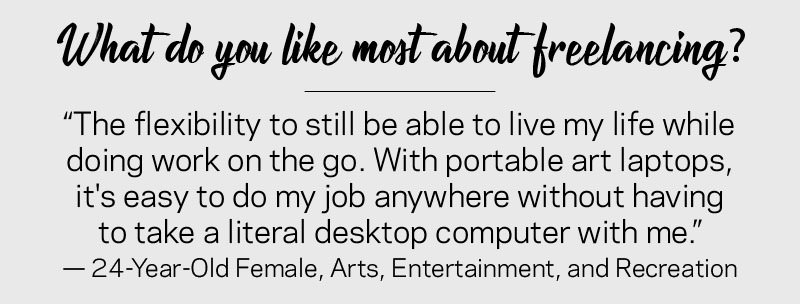 In some fields, the desire to eventually move on seemed quite strong: In the hospitality and wholesale and retail fields, a majority of workers anticipated changing industries in the coming years. Interestingly, however, 47 percent of technology workers expressed a desire to change fields as well, perhaps reflecting the prevalence of stress and burnout across the fast-paced, deadline-driven sector. Conversely, people in fields with a public service emphasis, such as education or government, seemed relatively settled, as did workers in arts and entertainment. Finance and insurance professionals followed suit and may find the compensation in their current positions too appealing to leave behind.
In some fields, the desire to eventually move on seemed quite strong: In the hospitality and wholesale and retail fields, a majority of workers anticipated changing industries in the coming years. Interestingly, however, 47 percent of technology workers expressed a desire to change fields as well, perhaps reflecting the prevalence of stress and burnout across the fast-paced, deadline-driven sector. Conversely, people in fields with a public service emphasis, such as education or government, seemed relatively settled, as did workers in arts and entertainment. Finance and insurance professionals followed suit and may find the compensation in their current positions too appealing to leave behind.
Independent industries?

 In some industries, workers said companies were deeply reliant on freelance labor currently, and that trend only promises to intensify over the next decade. Workers in arts, entertainment, and recreation and professionals in information services were particularly likely to take this view. On average, they estimated that over 40 percent of their industries already operated on a freelance basis, and more than 50 percent would do so in 10 years’ time. Marketing and technology workers felt freelancing would increase even more dramatically in their fields over that period. For some of Silicon Valley’s titans, that future has arrived already: At Google, contract workers now outnumber full-time employees.
In some industries, workers said companies were deeply reliant on freelance labor currently, and that trend only promises to intensify over the next decade. Workers in arts, entertainment, and recreation and professionals in information services were particularly likely to take this view. On average, they estimated that over 40 percent of their industries already operated on a freelance basis, and more than 50 percent would do so in 10 years’ time. Marketing and technology workers felt freelancing would increase even more dramatically in their fields over that period. For some of Silicon Valley’s titans, that future has arrived already: At Google, contract workers now outnumber full-time employees.  In some fields, however, workers felt traditional work arrangements would remain entrenched—to the extent that their jobs would continue to exist. In transportation and warehousing, for example, workers felt freelancing would scarcely increase over the next decade; by that time, steady jobs may be eliminated by automation, rather than contract workers. Government and public administration professionals also felt skeptical about freelancing increasing in their field, perhaps because rates of union membership remain relatively high in the public sector. Medical professionals didn’t anticipate growth in freelancing in their profession either; in fact, fewer physicians are even opening their own practices in recent years, preferring to join larger organizations instead.
In some fields, however, workers felt traditional work arrangements would remain entrenched—to the extent that their jobs would continue to exist. In transportation and warehousing, for example, workers felt freelancing would scarcely increase over the next decade; by that time, steady jobs may be eliminated by automation, rather than contract workers. Government and public administration professionals also felt skeptical about freelancing increasing in their field, perhaps because rates of union membership remain relatively high in the public sector. Medical professionals didn’t anticipate growth in freelancing in their profession either; in fact, fewer physicians are even opening their own practices in recent years, preferring to join larger organizations instead.
Enjoying the gig economy?
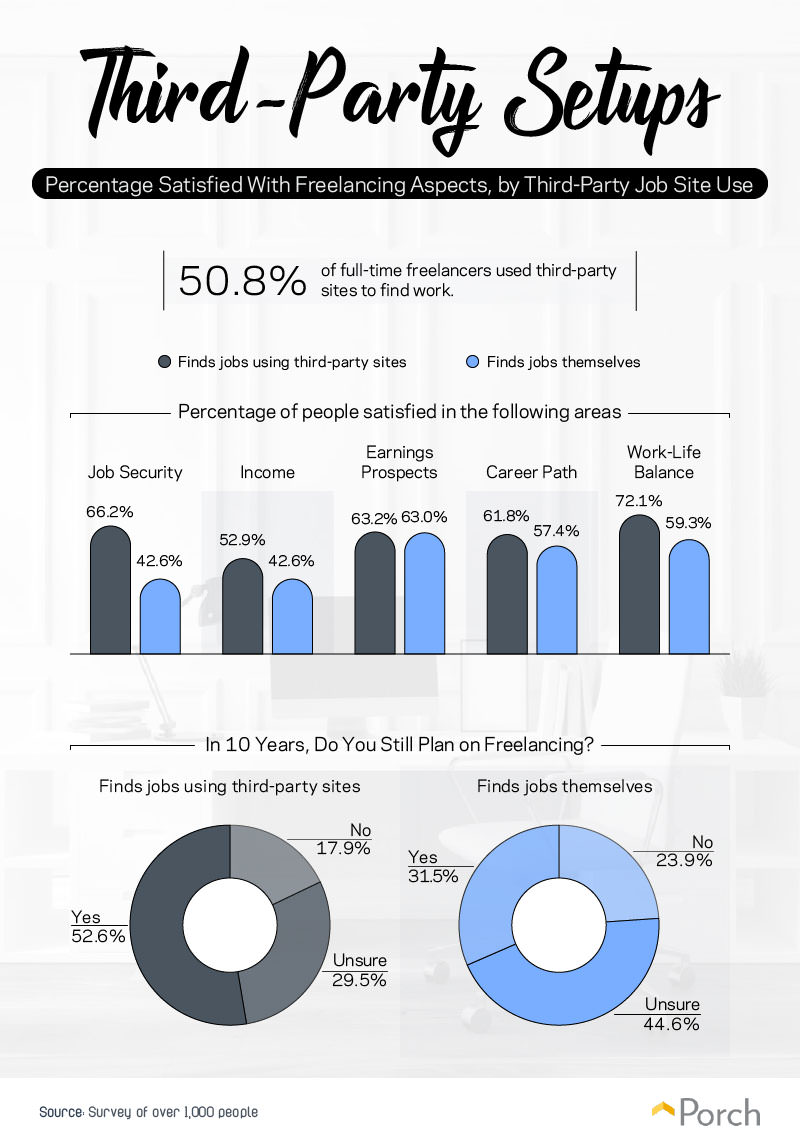
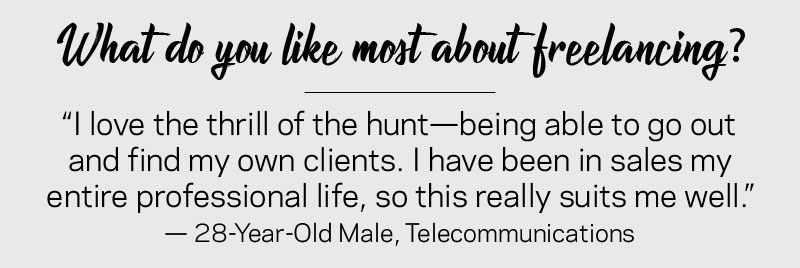 Among the current freelancers surveyed, roughly half reported using a third-party platform to ensure a flow of work, as opposed to drumming up opportunities themselves. Various sites and apps broker contract work slightly differently: Some aggregate open gigs and permit freelancers to apply for them, whereas others present freelancers’ rates and services, letting potential employers initiate discussions directly. Platform specifics aside, our data suggest they can dramatically improve the freelancing experience. Those who used third parties to find work were significantly more likely to be satisfied with their job security, annual income, and work-life balance.
Among the current freelancers surveyed, roughly half reported using a third-party platform to ensure a flow of work, as opposed to drumming up opportunities themselves. Various sites and apps broker contract work slightly differently: Some aggregate open gigs and permit freelancers to apply for them, whereas others present freelancers’ rates and services, letting potential employers initiate discussions directly. Platform specifics aside, our data suggest they can dramatically improve the freelancing experience. Those who used third parties to find work were significantly more likely to be satisfied with their job security, annual income, and work-life balance. 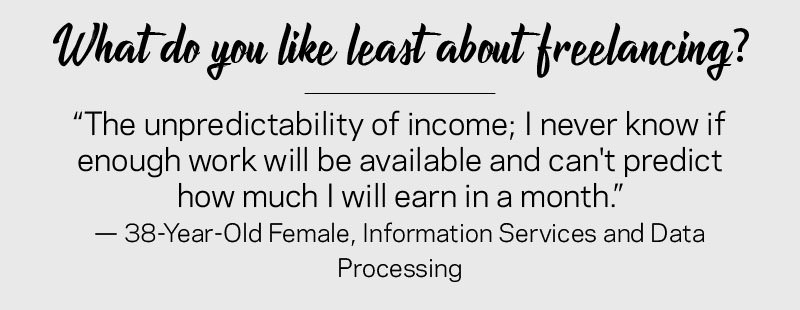 Third-party platforms also seemed to promote longevity, with more than half of users projecting that they’d still be freelancing in a decade. Conversely, less than a third of freelancers who found gigs alone felt they’d still be freelancing in 10 years’ time. Among those who anticipate leaving freelancing, however, the desired alternative may be retirement rather than a return to traditional employment. Indeed, older workers represent a substantial segment of self-employed Americans, many of who hope to stop working altogether in the years ahead.
Third-party platforms also seemed to promote longevity, with more than half of users projecting that they’d still be freelancing in a decade. Conversely, less than a third of freelancers who found gigs alone felt they’d still be freelancing in 10 years’ time. Among those who anticipate leaving freelancing, however, the desired alternative may be retirement rather than a return to traditional employment. Indeed, older workers represent a substantial segment of self-employed Americans, many of who hope to stop working altogether in the years ahead.
Portable professions
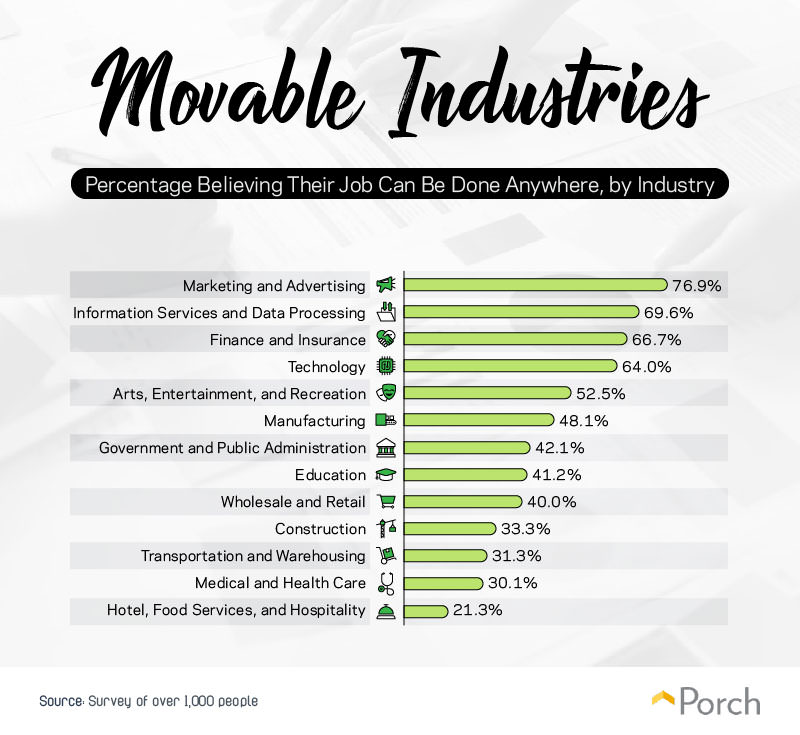 If contract work is redefining Americans’ career ambitions, the possibility of working remotely represents another powerful shift in the country’s professional culture. In fact, some experts boldly predict that a third of employees will work remotely in 10 years’ time and urge companies to make major adjustments accordingly. For workers in some fields, that transformation seems entirely possible. Over three-quarters of marketing professionals said they could do their jobs from any location. In information services, finance and insurance, more than two-thirds of workers said the same. Of course, some fields are rooted in physical services: In hospitality, for example, merely 21 percent of workers felt their duties were location-independent. In transportation and construction, roughly a third of workers felt they could function remotely, although remote management positions do exist in these industries. Additionally, just 3 in 10 medical professionals felt they could perform their duties remotely, despite the increasing virtualization of the healthcare field. Industry analysts project that virtual doctor appointments will only grow in popularity, driving down costs and increasing on-demand access to care.
If contract work is redefining Americans’ career ambitions, the possibility of working remotely represents another powerful shift in the country’s professional culture. In fact, some experts boldly predict that a third of employees will work remotely in 10 years’ time and urge companies to make major adjustments accordingly. For workers in some fields, that transformation seems entirely possible. Over three-quarters of marketing professionals said they could do their jobs from any location. In information services, finance and insurance, more than two-thirds of workers said the same. Of course, some fields are rooted in physical services: In hospitality, for example, merely 21 percent of workers felt their duties were location-independent. In transportation and construction, roughly a third of workers felt they could function remotely, although remote management positions do exist in these industries. Additionally, just 3 in 10 medical professionals felt they could perform their duties remotely, despite the increasing virtualization of the healthcare field. Industry analysts project that virtual doctor appointments will only grow in popularity, driving down costs and increasing on-demand access to care.
Remote revolution
 Some professionals anticipate robust remote work opportunities in their fields: Information services workers or virtual assistants, for example, felt the majority of their industry would be working remotely in 10 years’ time. In marketing and technology, professionals felt remote employment would approximately double; some research suggests dissatisfaction in these industries that working from home isn’t permitted more broadly already. Yet, the future of remote work is far from certain at some major firms in these sectors. Yahoo and IBM have reversed course on once-generous work-from-home policies, citing issues with employee collaboration and accountability. In some fields, workers reported few remote employment opportunities and anticipated little growth in this area. These industries included manufacturing and hospitality, where one’s physical presence is undeniably essential in many cases. Government employees reported the fewest remote work opportunities in their fields currently, although some experts suggest even slow-moving municipalities will soon see the upside in allowing employees to telecommute. With many essential government services, however, remote employment simply isn’t feasible: Police officers and firefighters can’t perform their work from home.
Some professionals anticipate robust remote work opportunities in their fields: Information services workers or virtual assistants, for example, felt the majority of their industry would be working remotely in 10 years’ time. In marketing and technology, professionals felt remote employment would approximately double; some research suggests dissatisfaction in these industries that working from home isn’t permitted more broadly already. Yet, the future of remote work is far from certain at some major firms in these sectors. Yahoo and IBM have reversed course on once-generous work-from-home policies, citing issues with employee collaboration and accountability. In some fields, workers reported few remote employment opportunities and anticipated little growth in this area. These industries included manufacturing and hospitality, where one’s physical presence is undeniably essential in many cases. Government employees reported the fewest remote work opportunities in their fields currently, although some experts suggest even slow-moving municipalities will soon see the upside in allowing employees to telecommute. With many essential government services, however, remote employment simply isn’t feasible: Police officers and firefighters can’t perform their work from home.
Employers’ opinions
 Of the employers included in our survey, two-thirds said they permitted working from home to some extent. Perhaps this cohort has been convinced by some of the evidence that remote workers are admirably productive—or they simply view it as a valuable perk for current and prospective employees. Even 39 percent of those who didn’t currently allow working from home said they’d be willing to consider it in the future, indicating substantial flexibility on this front. In some fields, remote work may come to be seen as an essential tool in attracting talent. One recent survey found that most technology professionals would take a pay cut to work from home at least half the time. Of course, a sizeable contingent remained firmly opposed to remote work on principle: More than a quarter of employers said they wouldn’t consider permitting it in the future. Some critics say this anti-remote stance stems from fear of change among executives, rather than careful deliberation. But among employers who offer remote work opportunities currently, 8 percent said they would not continue to do so in the years to come. This finding suggests against painting with a broad brush: As with many workplace policies, the pros and cons of permitting remote work seem contingent on each company’s culture.
Of the employers included in our survey, two-thirds said they permitted working from home to some extent. Perhaps this cohort has been convinced by some of the evidence that remote workers are admirably productive—or they simply view it as a valuable perk for current and prospective employees. Even 39 percent of those who didn’t currently allow working from home said they’d be willing to consider it in the future, indicating substantial flexibility on this front. In some fields, remote work may come to be seen as an essential tool in attracting talent. One recent survey found that most technology professionals would take a pay cut to work from home at least half the time. Of course, a sizeable contingent remained firmly opposed to remote work on principle: More than a quarter of employers said they wouldn’t consider permitting it in the future. Some critics say this anti-remote stance stems from fear of change among executives, rather than careful deliberation. But among employers who offer remote work opportunities currently, 8 percent said they would not continue to do so in the years to come. This finding suggests against painting with a broad brush: As with many workplace policies, the pros and cons of permitting remote work seem contingent on each company’s culture.
Domestic distractions?
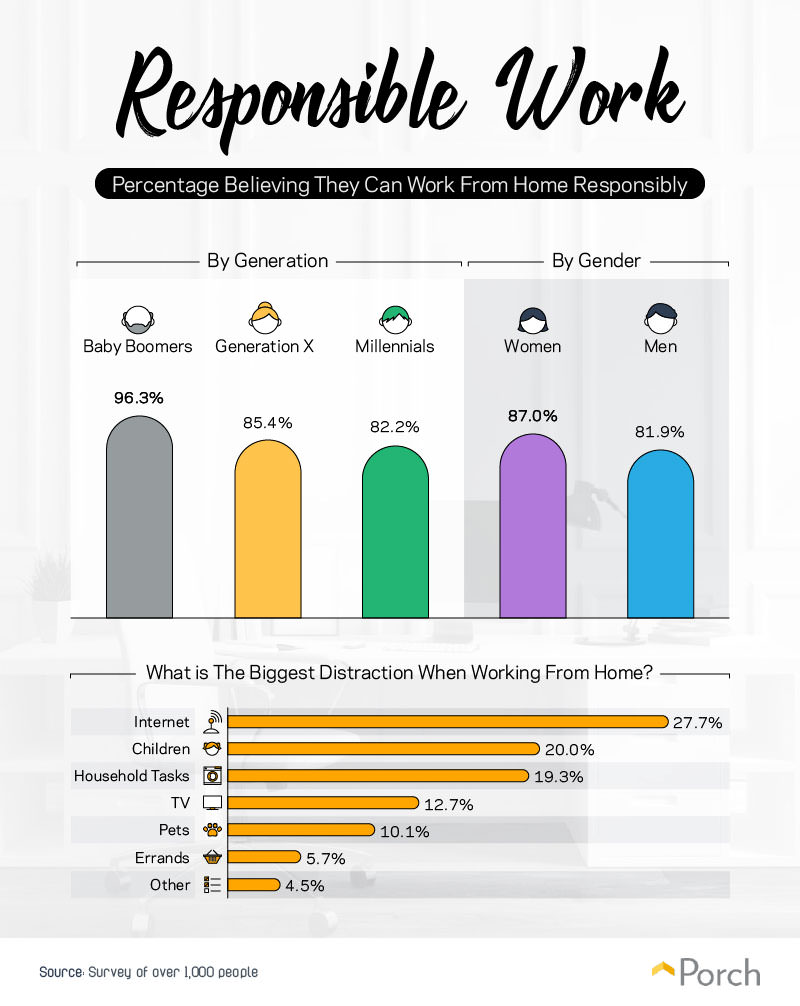
 If some employers are cautious about allowing workers to go remote, how many professionals would trust themselves to perform their duties from home and keep track of their time? The vast majority felt confident in their powers of self-control, although this certainty declined with each successive generation. Interestingly, women were more likely to feel responsible enough to go remote than their male peers. Some commentators have suggested that remote work might help counteract deep-seated gender inequalities in some industries; the opportunity to telecommute could help working moms continue their career trajectories. When asked to consider the obstacles they might encounter when working from home, 28 percent of respondents cited the tool that enables remote work in the first place, the internet. Other top sources of distraction didn’t exactly qualify as entertainment: 20 percent of people felt they’d be sidetracked by caring for children, and a similar percentage felt they’d be tempted to perform household chores. For this reason, veteran remote workers suggest making sure your workspace is free from clutter and visible signs of other tasks that need doing. Additionally, getting out of the house can offer an important productivity boost.
If some employers are cautious about allowing workers to go remote, how many professionals would trust themselves to perform their duties from home and keep track of their time? The vast majority felt confident in their powers of self-control, although this certainty declined with each successive generation. Interestingly, women were more likely to feel responsible enough to go remote than their male peers. Some commentators have suggested that remote work might help counteract deep-seated gender inequalities in some industries; the opportunity to telecommute could help working moms continue their career trajectories. When asked to consider the obstacles they might encounter when working from home, 28 percent of respondents cited the tool that enables remote work in the first place, the internet. Other top sources of distraction didn’t exactly qualify as entertainment: 20 percent of people felt they’d be sidetracked by caring for children, and a similar percentage felt they’d be tempted to perform household chores. For this reason, veteran remote workers suggest making sure your workspace is free from clutter and visible signs of other tasks that need doing. Additionally, getting out of the house can offer an important productivity boost.
Optimizing your home—for work
Our data suggest that freelance and remote working arrangements are especially prevalent in some industries, but that similar changes will soon arrive in other fields as well. As these trends intensify, several related questions confront employers and workers: How can these opportunities be distributed equitably, and how should employees navigate the distinct challenges that nontraditional gigs entail? For all the flexibility that freelancing and working from home seem to offer, they require real trade-offs in terms of support and stability. As the nature of work in America continues to evolve, companies must seek new ways to empower those they employ—no matter the terms of their arrangements. Simultaneously, individuals who embrace remote work or a freelancing career must make choices to support their own success—without a corporate entity encouraging your productivity, it’s important to invest in your own performance. That begins with a dedicated workspace free from the distractions elsewhere in your home. With trusted pros in your local area, Porch can help you create the home office you need to gain professional peace. Consult our project guides and recommended contractors to get started.
Methodology and limitations
To find the data used in this piece, we surveyed 1,002 people on their attitudes toward and experiences with the freelance economy and working from home. All answers were self-reported and may be limited by common issues with self-reported data, including recency bias, telescoping, and more. Respondents were given answer choices to select the industry that best fit their work. Only employed people were surveyed. For any industry or other demographic information presented, we required a sample size of at least 25 of each demographic. Our survey pool consisted of 480 women, 518 men, and four with alternative responses. Ages of respondents ranged from 18 to 81 with an average of 36 and a standard deviation of 10.67. 291 of the respondents were employers, and only their answers were considered for questions aimed at people with hiring and firing power.
Sources
- https://www.theguardian.com/business/2018/jun/07/america-gig-economy-work-bureau-labor-statistics
- https://qz.com/work/1392302/more-than-5-of-americans-now-work-from-home-new-statistics-show/
- https://www.inc.com/scott-mautz/a-2-year-stanford-study-shows-astonishing-productivity-boost-of-working-from-home.html
- https://www.bls.gov/news.release/atus.nr0.htm
- https://www.forbes.com/sites/larryalton/2018/01/22/millennials-arent-job-hopping-young-people-are-5-things-to-keep-in-mind/#21a323e010d8
- https://money.usnews.com/careers/applying-for-a-job/articles/2018-06-18/how-to-find-a-bridge-job-or-second-career-before-retirement
- https://www.forbes.com/sites/laurencebradford/2018/06/19/why-we-need-to-talk-about-burnout-in-the-tech-industry/#a0ec0bc14063
- https://www.businessinsider.com/finance-jobs-highest-salaries-2018-4#2-managing-partner-14
- https://www.cnbc.com/2018/10/22/silicon-valley-using-contract-employees-to-drive-profits.html
- https://www.nbcnews.com/business/autos/millions-professional-drivers-will-be-replaced-self-driving-vehicles-n817356
- https://www.bls.gov/news.release/union2.nr0.htm
- https://wire.ama-assn.org/practice-management/first-time-physician-practice-owners-are-not-majority
- https://www.usatoday.com/story/money/columnist/strauss/2018/07/12/strauss-column-gig-economy/773914002/
- https://www.aarp.org/work/working-at-50-plus/info-2018/boomers-freelance-self-employed.html
- https://www.inc.com/suzanne-lucas/survey-most-companies-lack-a-telecommuting-policy-heres-how-to-get-yours-started.html
- https://www.forbes.com/sites/zackfriedman/2018/09/18/17-surprising-remote-jobs-with-a-great-salary/#13c78c2313fa
- https://www.beckershospitalreview.com/telehealth/telemedicine-is-here-to-stay-telehealth-the-return-on-investment.html
- https://www.entrepreneur.com/article/322418
- https://www.nbcnews.com/business/business-news/ibm-tells-its-remote-employees-get-back-office-n763441
- http://www.governing.com/columns/smart-mgmt/gov-telework-public-sector.html
- https://www.forbes.com/sites/larryalton/2017/03/07/are-remote-workers-more-productive-than-in-office-workers/#4ca6c88731f6
- https://www.forbes.com/sites/forbesbusinessdevelopmentcouncil/2018/04/17/three-most-in-demand-employee-benefits-of-2018/#599c4b6e5510
- https://www.forbes.com/sites/lizryan/2017/03/15/the-real-reason-youre-not-allowed-to-work-from-home/#1c22a2e27084
- https://www.forbes.com/sites/andrealoubier/2017/03/13/how-working-remotely-is-helping-women-close-the-gender-gap-in-tech/#6a2077fa4ea7
- https://www.inc.com/young-entrepreneur-council/maximize-productivity-at-home-with-these-6-remote-work-hacks.html
Fair use statement
Freelance or full time, workers appreciate a little credit for a job well done. We’re no exception, which is why we hope you’ll attribute us if you share this content. To do that, just link back to this page when you use our work—and please only do so for noncommercial purposes.
